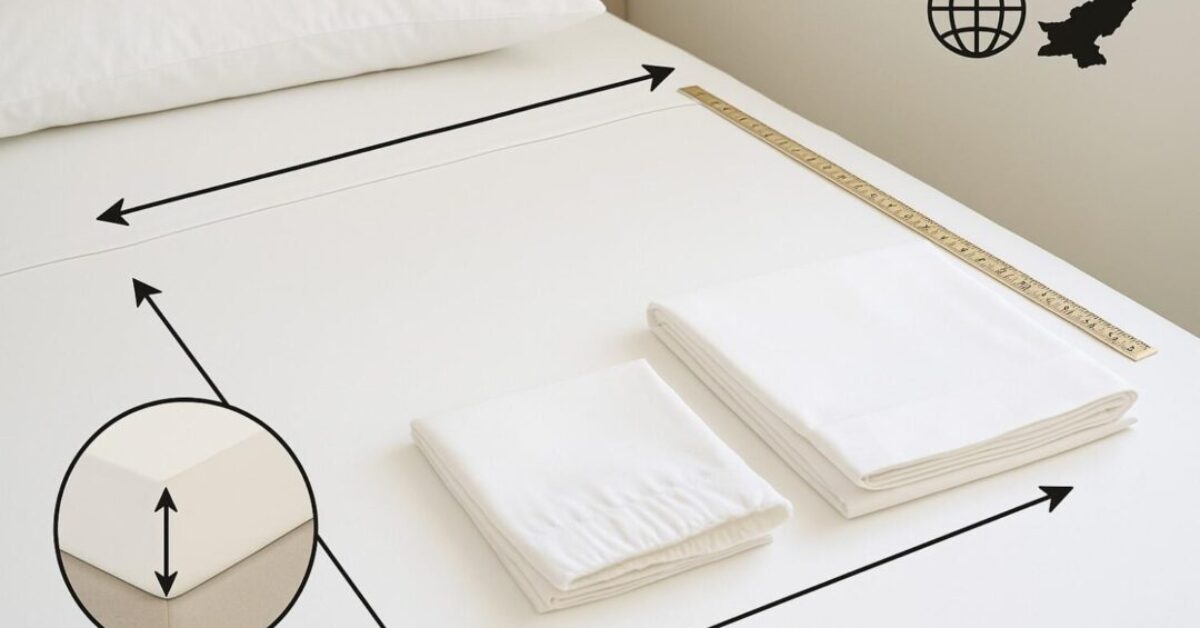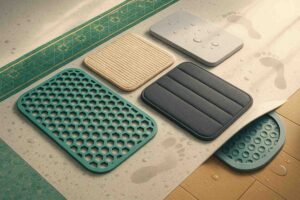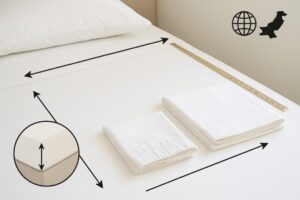Let’s end the 11 p.m. wrestling match with your fitted sheet.
This is a global first, Pakistan rooted size guide that translates mattress dimensions into flat and fitted sheet picks that actually fit, whether you’re outfitting a home in Karachi, a rental in Dubai, a London flat (with a topper), or a Toronto bedroom that runs cold nine months a year. We’ll cover US/NA, UK, EU, and Pakistan sizes, explain pocket depths (the number no one tells you), and share a simple measurement ritual that stops the corner pop at 3 a.m.
There’s a printable chart linked above save it to your phone or share it with your housekeeper or procurement team.
1) The 30 second cheat sheet
- Beds aren’t global. A US King ≠ UK King ≠ PK King.
- Fitted sheets fail not because of width/length, but because pocket depth is too shallow for your mattress + topper.
- Flat sheets look and feel better when you add tuck allowance: roughly +18 in width and +22 in length (≈45 x 56 cm) beyond the mattress top.
- Shrinkage is real. Expect ~2–4% after the first few washes in cotton. Good makers pre shrink and cut with allowance.
- If you host international guests or export, keep both a global and a Pakistan chart handy (we included both).
2) Mattress sizes by region (why they differ)
Here’s the “why” behind the chaos:
- US/NA standardizes around 39/54/60/76/72 inches widths with common lengths 75/80/84.
- UK leans on metric base sizes (90/135/150/180 cm widths) but retailers still list inches.
- EU sits at 90/140/160/180 x 200 cm.
- Pakistan uses a mix: commonly Single 42×78 in, Double 48×78 in, Queen 60×78 in, King 72×78 in but local brands do vary.
That’s why we built a unified table you can download: it maps mattress size → fitted pocket options → flat sheet size across regions.
3) Fitted sheets: the number that matters is pocket depth
If your fitted sheet keeps popping off, check depth not just size.
Pocket depth ranges (global shorthand):
- Standard: 12–14 in (30–36 cm)
- Deep: 15–17 in (38–43 cm)
- Extra deep: 18–22 in (46–56 cm)
How to choose:
- Measure your mattress with topper at the deepest point.
- Add ~1–2 in (2.5–5 cm) for shrinkage and tuck.
- Pick the pocket range that exceeds that number.
Example: Mattress + topper measures 14 in deep. Choose Deep (15–17 in). Standard will fight you; extra deep will feel baggy.
4) Flat sheets: give yourself room to tuck
A flat sheet looks and sleeps better when you have tuck allowance on all sides specially for hospital corners.
Simple rule:
Mattress top size + 18 in (45 cm) in width + 22 in (56 cm) in length.
Why more length? You need end tuck at the foot of the bed, and if you fold back at the headboard, you’ll want extra.
5) The printable chart (what’s inside)
- Regions: US/NA, UK, EU, Pakistan
- Mattress WxL in inches and cm
- Fitted recommendation: top area matching the mattress + your chosen pocket depth range (Standard/Deep/Extra Deep)
- Flat recommendation: width/length with the tuck allowance baked in
Use it two ways:
- Home: pick one region’s row, match your bed, choose pocket depth.
- Hospitality/Exports: use the chart to standardize specs by property or market. Add pocket depth to your linen spec sheet so procurement doesn’t guess.
6) How to measure once and never think about it again
Grab a tape and do this five-minute ritual (works anywhere):
- Width & length: measure the mattress top (seam to seam).
- Depth: include any toppers or protectors. Measure at the deepest corner.
- Record in inches and cm (your future self or your housekeeper will thank you).
- Pick your pocket range: Standard, Deep, Extra Deep.
- Decide flat vs fitted: Most people use fitted for everyday ease + one flat for layering/guests.
Pro tip: write the depth on a label and stick it inside the bed frame. When you buy or replace sheets, you won’t have to re measure.
7) Fitted vs flat: when each makes life easier
Fitted:
- Fast bed making, secure corners, especially good for rentals/guest turnover.
- Needs the right pocket depth; buy the wrong one and it’s a nightly argument.
Flat:
- Universally flexible, especially for tricky sizes, high toppers, or mixed markets.
- Great for hotel corners and a polished look.
- Adds a layer between sleeper and duvet/blanket, which means less frequent duvet washing.
Hybrid approach: Everyday fitted for ease + one flat for layering, guests, or heat waves.
8) Global notes (Pakistan rooted)
- Pakistan Queen/King vs US/UK sizes: A Pakistan King (72 x 78 in) is closer to a US short King in length and a UK Super King in width (but shorter). Always check your region’s row in the chart.
- Exporting gifts or outfitting family abroad? Pack a set that matches their standard, not yours.
- Mattress protectors (common in hospitality and rentals) add depth; measure again after installing.
9) Shrinkage, laundering & why good makers pre-shrink
Cotton will relax and then settle in the first few launderings. Expect around 2–4% dimensional change if the fabric wasn’t properly preshrunk. Ranyal sets are preshrunk and cut with a practical tolerance so you don’t lose fit after week one.
Care tips that protect fit:
- Wash cool to warm with a mild detergent.
- Skip heavy softeners; they coat fibers and reduce breathability (percale and sateen both suffer).
- Dry on medium and pull while slightly warm to fold.
- Don’t mix sheets with rough items (zippers, hook and loop) that can snag specially on sateen.
10) Pillowcases & duvets (quick add-Ons so the set matches)
Pillowcases:
- US/NA: Standard ~20×26 in, Queen ~20×30 in, King ~20×36 in.
- UK/EU: similar widths but often in cm; check the pillow insert.
- Pakistan: commonly follows US widths; check your insert label.
Choose envelope closures if you want a tidy look that hides the pillow.
Duvets/comforters:
- US/NA: Twin, Full/Queen, King/Cal King; check exact inches brands vary.
- UK/EU: Single, Double, King, Super King (mostly 200 220 cm lengths).
- Pakistan: often aligns to bed sizes; check local brand dimensions.
If you like generous drape, size one step up from your mattress width (e.g., Queen bed with a King duvet).
11) Common mistakes (and easy fixes)
- Wrong pocket depth: If your sheet was “fine until I added a topper,” you need the next pocket range.
- Buying by the bed name only: Always cross check actual dimensions.
- Ignoring shrinkage: If your fitted sheet was barely enough on day one, it won’t survive wash three.
- Skimming specs online: A credible product page lists fiber, weave, size in inches/cm, and pocket depth.
12) For hospitality & rentals: lock your spec
Create a one-page linen spec for each property or market:
- Mattress size (in/cm) + depth
- Fitted: region + pocket range
- Flat: width x length
- Pillowcase: size and closure
- Duvet cover: width x length
- Housekeeping note: “Deep pocket in winter only” or “Flat sheet for all rooms,” etc.
13) Materials & fit (because feel matters too)
Fit is step one; feel is step two. If you run hot, a percale set in the right size will beat a wrongly sized sateen any night. If you love a soft, drapey bed, sateen in a matched pocket depth is joy.
Deep dives for feel (internal links for your CMS):
- Percale vs Sateen: Which Sheets Feel Right for You?
- Bedsheet Thread Count Myth: What Actually Matters
14) A “choose and forget” shopping list
For each bed in your home (or property), note:
- Region row to follow (US/NA, UK, EU, Pakistan)
- Mattress WxL and Depth (with topper)
- Fitted pocket range (Standard/Deep/Extra Deep)
- Flat sheet size (with allowance)
- Pillowcase sizes
- Duvet/Duvet cover size (consider sizing up for drape)
Save that to Notes and you never have to re-measure.
Ranyal’s take (global first, Pakistan rooted)
We cut to region specific standards, build honest pockets (Standard/Deep/Extra Deep), and pre-shrink for stability. Whether you’re making beds in Karachi or coordinating a guest room in London, the goal is the same: the sheet fits, looks clean, and stays put.
If you’re torn between two options, go deeper on pocket depth and larger on flat sheets. Too much cloth can be tucked; too little has no fix.
FAQ
Are Pakistan “King/Queen” the same as US?
No. A Pakistan King (72×78 in) differs from a US King (76×80 in) and a UK Super King (72×78 in approx.). Always check dimensions.
Do I need extra deep pockets?
Only if your mattress + topper depth is above ~17 in (43 cm). Measure first.
Will my sheets shrink?
Quality cotton may shift ~2–4% initially. Preshrunk fabrics and good care keep fit true.
Flat or fitted what’s better?
For everyday speed, fitted. For tricky sizes, toppers, or polished corners, flat. Many homes keep both.
Why do fitted sheets pop off?
Pocket too shallow, elastic too weak, or mattress corners very rounded. Go up a pocket range and choose full elastic styles.




